|
|
|
Sort Order |
|
|
|
Items / Page
|
|
|
|
|
|
|
| Srl | Item |
| 1 |
ID:
178304
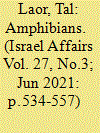

|
|
|
|
|
| Summary/Abstract |
Digital platforms have become a major tool for media figures. The Internet offers the media essential tools, most notably authentic and accessible sources of information and the absence of censorship. Digital media provides media personalities with a platform that is free and fast where they can express themselves freely without ‘gatekeepers.’ Drawing on Deuze’s five-dimensional model of journalism, this article shows that for the content transfer platform, the network is characterised by a young audience, leading to more consumer confidence due to its authentic nature. It also found that platform selection relates directly to content and that media people use the network to promote agendas. In addition, their influence on social networks is greater because they are bi-directional and allow for audience reaction. As for the media figure’s personality, it was found that the success of media figures does not involve the quality of the content but the admiration of the audience. In addition, it emerged from the interviews that technological determinism affects media figure activities such that ‘the medium is the message’ – type of media dictates choice of the content transfer platform, content, and media figure personality.
|
|
|
|
|
|
|
|
|
|
|
|
|
|
|
|
| 2 |
ID:
175470
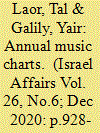

|
|
|
|
|
| Summary/Abstract |
Radio is a cultural producer and a main player in the music industry. Radio operates a system that determines which music will be broadcast and which music will not make it ‘on the air,’ functioning as gatekeeper for the general audience. Such a system gives radio significant influence on the music to which listeners are exposed. By way of offering a comprehensive picture of the diverse tastes, styles and trends of popular music in Israel, this article examines the mix of the common musical taste in Israeli society as reflected in the audience votes for the annual music charts that were broadcast on Gal Galatz radio station for 15 years. Findings show that pop music is the most common music in the charts and accounts for 45%, in contrast to rock music, which shows a declining trend. Mediterranean music has grown in popularity in recent years to become an integral part of mainstream music and accounts for a significant proportion of the mix of popular music according to Israeli listeners.
|
|
|
|
|
|
|
|
|
|
|
|
|
|
|
|
| 3 |
ID:
151819
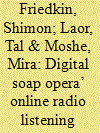

|
|
|
|
|
| Summary/Abstract |
This article examines the gendered digital divide in Israel in the age of the radiophonic cyber-revolution. The research focuses on increased listening patterns to on-demand, radiophonic content via online radio. Recent years have witnessed a shift in the second level of the gendered digital divide. This shift is effectively captured by the notion of ‘can’t’ transforming into a ‘don’t want to be bothered’ mindset. To explore this phenomenon an online survey was conducted on online listeners of a regional radio station. Israel’s top-rated regional station, 103FM-Non-Stop Radio, was selected. The survey was conducted in April 2014. A total of 2013 listeners were surveyed: 1491 men and 522 women. Our results found that for the under 35 years of age listeners increased listening patterns were gender-blind. The same conclusion was reached for other demographic groups: The findings from this group do, in fact, attest to a gendered digital divide. The key demographic groups here are married couples and parents. These trends highlight the continued need for further research into online radio listening patterns and their relationship to gender-related differences in the digital age.
|
|
|
|
|
|
|
|
|
|
|
|
|
|
|
|
| 4 |
ID:
186055
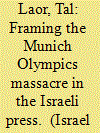

|
|
|
|
|
| Summary/Abstract |
This article analysed the real-time coverage of the 1972 Munich Olympics massacre by the three main Israeli newspapers at the time: Yediot Ahronot, Maariv and Haaretz. It found that while there were noticeable differences in the coverage of the event by the three papers, all of them framed the massacre as integral part of the black-and-white confrontation between Israel and Arab terrorism. Paradoxically, this ‘us’ vs. ‘them’ dichotomy seems to have played into the perpetrators’ hands by casting them as part of a formidable global terrorist network rather than a small fringe group, on the one hand, and as a significant factor affecting the possible evolution of Arab-Israeli peace negotiations, on the other
|
|
|
|
|
|
|
|
|
|
|
|
|
|
|
|
| 5 |
ID:
158163
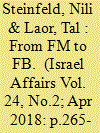

|
|
|
|
|
| Summary/Abstract |
The article explores Israeli radio stations’ activity on Facebook and analyses the most popular content in terms of various engagement indexes. It finds that the format of a post, its language and content, all affect the level and nature of user engagement with the post. Moreover, it appears that both stations and users turn to Facebook primarily for promotional and PR purposes and less so for promoting mutual interaction and dialogue between stations and their audiences, thus complementing the traditional medium without utilising the full range of opportunities this new platform has to offer radio.
|
|
|
|
|
|
|
|
|
|
|
|
|
|
|
|
| 6 |
ID:
170705
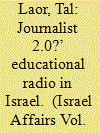

|
|
|
|
|
| Summary/Abstract |
Educational radio stations in Israel, which have operated for at least 25 years, are inspired by the American college radio. This article investigated the functions and contributions of radio to students and to the media industry in general and radio broadcasts in particular. A research survey was distributed on aspects of the media industry and interviews with educational radio activists were conducted. The findings indicate that schools of communication believe and invest in integrating practical experience. As a result, students acquire abilities and practical skills as well as knowledge of the communications world. Students operate educational radio stations with high levels of motivation and self-fulfillment. These student efforts and support from academic institutions bear fruit as the media industry acknowledges the value of educational radio studies graduates and appreciates their preparedness to integrate into the industry.
|
|
|
|
|
|
|
|
|
|
|
|
|
|
|
|
| 7 |
ID:
174580
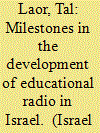

|
|
|
|
|
| Summary/Abstract |
For over 25 years, college radio stations have been operating in academic institutions in Israel. This article explores the main milestones in the development of college radio in Israel; the processes of establishment and ideological vision and goals underlying them; and the impact of college radio on political, social and cultural history of Israel.
|
|
|
|
|
|
|
|
|
|
|
|
|
|
|
|
| 8 |
ID:
154503
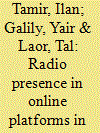

|
|
|
|
|
| Summary/Abstract |
This article explores the ways in which the medium of radio is currently being used on Israel’s various online platforms. It shows how via their internet presence, radio stations have begun broadcasting live online, offering select segments of their programmes, and maintaining correspondence and dialogue with their listeners. Moreover, the traditional radio stations have also been staking their claim to social media with a growing number of them not only present on Facebook, Twitter, LinkedIn, and YouTube, but also branching out to a variety of mobile apps in an attempt to engage with their listeners.
|
|
|
|
|
|
|
|
|
|
|
|
|
|
|
|
| 9 |
ID:
192902
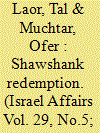

|
|
|
|
|
| Summary/Abstract |
Israeli prisons have recently initiated a rehabilitation program known as Prison Radio. This article suggests that since prison radio shares similar characteristics with educational radio, inmates may operate the radio stations with high motivation and self-fulfilment since they determine the content of the programs. Inmates may also acquire work-related tools and habits and strengthen their self-confidence, which allows adopting constructive behavioural patterns. Therefore, empowering prisoners through radio station activities may encourage their normative reintegration into society.
|
|
|
|
|
|
|
|
|
|
|
|
|
|
|
|
| 10 |
ID:
161387
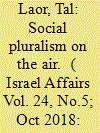

|
|
|
|
|
| Summary/Abstract |
Internet radio stations that broadcast exclusively on the Internet are a growing phenomenon in Israel, providing a stage for new and diverse voices in Israeli society. This article charts the activity of Internet radio stations in Israel and evaluates their social contributions by focusing primarily on music selection, broadcast content, and target audiences. It shows that the establishment of Internet radio stations is connected to progressive trends in Israeli society. New and varied voices, not necessarily heard before in traditional media and especially traditional radio, have been given a platform for the first time. This makes Internet radio an important expression of social pluralism in communications media, which is essential and necessary for the healthy maintenance of a democratic society with so many internal divisions.
|
|
|
|
|
|
|
|
|
|
|
|
|
|
|
|
| 11 |
ID:
183996
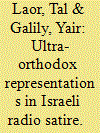

|
|
|
|
|
| Summary/Abstract |
The growing power of the media to define social values and perceptions is a conspicuous feature of contemporary life. Radio is one such shaper of social reality perceptions. While much of the media research focuses on secular organisations operating in a Western, liberal context, not much attention has been paid to this tension between religion and modernity within media outlets. This article examines representations of Israel’s Jewish ultra-orthodox minority in Israel’s daily radio satire shows, a popular and intuitive medium. It shows that content is usually based on the broadcasters’ spontaneous feelings contrary to other media. The findings in the article depict an isolated community out of touch with public consensus and mainstream society.
|
|
|
|
|
|
|
|
|
|
|
|
|
|
|
|
|
|
|
|
|